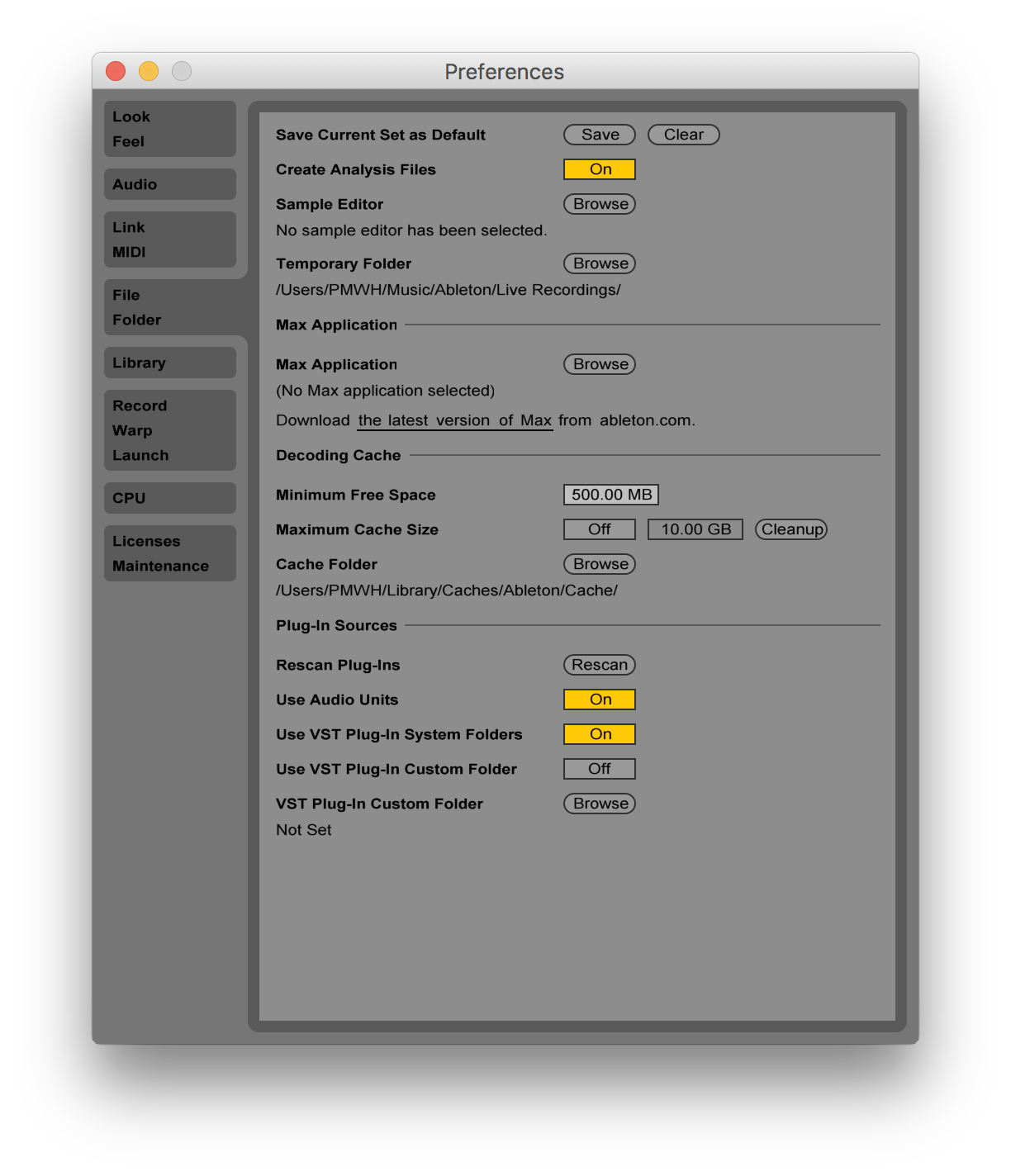Using Waves plugins with a custom VST folder. A special file called a WaveShell is installed to the default plug-in folder. However if you're using a custom VST folder then you need to locate the WaveShell file and move it to that folder. See our dedicated article: Using Waves plug-ins with a custom VST folder. Here's some instructions to show you how to use VST plugins in Ableton Live: Ableton Live. Setup your VST Plug-ins Directory. Mac OS X users can skip this step! In the Ableton Live preferences, go to the 'File Folder' tab. Ensure 'Use VST Plug-In Custom Folder' is ON, and click 'Browse' to choose the folder where all your VST plugins are. May 26, 2017 This feature is not available right now. Please try again later.
Delicious Audio Software and Plug-ins
ProductsInternet Radio Broadcasting
Rocket Broadcaster
Internet radio broadcast encoder.
Rocket Streaming Audio Server
Deliver streaming audio over the web.
Radio Mast
Streaming audio cloud platform.
Music Production
BeatCleaver
Audio editor and sample slicer.
JamDeck
Organic music sketchpad.
VST Plug-ins
SodaSynth
Classic mellow synthesizer.
Analog Extracts
Raw analog synth samples.
Our SodaSynth and Analog Extracts plugins are both available as VST plugins on Windows, and compatible with Ableton Live. Here's some instructions to show youhow to use VST plugins in Ableton Live:
Ableton Live
Setup your VST Plug-ins Directory
Mac OS X users can skip this step!
In the Ableton Live preferences, go to the 'File Folder' tab.Ensure 'Use VST Plug-In Custom Folder' is ON, and click 'Browse' to choose the folder where all your VST plugins are.After that, click 'Rescan' to make sure Ableton Live has refreshed the list of installed plugins.
Is the monitor turned off on your work computer?
 And some graphics cards will not do hardware acceleration if they don't detect that they're connected to a monitor (like if the monitor is turned completely off or disconnected). Any help is appreciated, thanks!. Under those conditions, those programs will throw up a blank screen when you try to view remotely.If that's what's happening, one solution is to install a dummy monitor plug (sometimes called headless ghost plug or display emulator plug) on the remote machine. If so, that's probably the problem.I don't really know the technical details of it, but some programs use video hardware acceleration and some don't.
And some graphics cards will not do hardware acceleration if they don't detect that they're connected to a monitor (like if the monitor is turned completely off or disconnected). Any help is appreciated, thanks!. Under those conditions, those programs will throw up a blank screen when you try to view remotely.If that's what's happening, one solution is to install a dummy monitor plug (sometimes called headless ghost plug or display emulator plug) on the remote machine. If so, that's probably the problem.I don't really know the technical details of it, but some programs use video hardware acceleration and some don't.On Windows, Oscillicious VST plugins install to 'C:VST Plugins' by default, or 'C:VST Plugins (64-bit)' for 64-bit plugins.
On Mac OS X, Oscillicious plugins install to the system-wide standard VST plugins folder, so no configuration is required (/Library/Audio/Plug-Ins/VST).
Open the Plug-in Devices Tab
Back in the main window, click the icon to open the Plug-In Devices tab. This tab displays a listof all the plugins Ableton Live has detected on your computer, by looking in both system-standard paths and your custom VST folder that we set up in the previous step.
Add a Plug-In Instrument to a Track
Double-click on one of the plug-in instruments in the list to add it to a track, or drag and drop it to the specific track you'd like to add it to.For example, you'll if you double-click on SodaSynth, you should SodaSynth added to a track in the Sesion or Arrangement view, and appear in the bottom panel.
Select a VST Preset
VST presets (synth patches or programs) appear in the bottom panel, and have been circled in red in the next screenshot. Clicking on that combobox allows you toquickly select any of the presets bundled with the VST plugin.
Open the Custom VST Editor
Most VST plugins come with a built-in custom editor screen, with knobs and extra help. Clicking the iconbeside the SodaSynth label in Ableton Live will open up the SodaSynth editor, which gives you access to our extra help screens.
Adjusting Parameters inside Ableton Live
Clicking the icon beside the SodaSynth label will open up the parameter area, allowing you to adjust the VST plugin'sparameters directly from inside Ableton Live. Right-clicking on a parameter allows you to set up automation curves and MIDI mappings for that parameter.
Compose!
Create a MIDI part and in the track that you added the SodaSynth VST instrument to, and either record from your MIDI keyboard or start writing a melody in the MIDI editor. If youwant to fatten up SodaSynth's sounds a bit, try adding a little bit of chorus or delay using the built-in Ableton Live effects.
That's it! This tutorial covered how to setup your VST plugins folder in Ableton Live, how to find plug-in devices and add them to a track, and how to change VST presets and paramters using both the Ableton Live and a plugin's custom VST editor. From here, you can use VST plugins as instruments in tracks, and create MIDI parts that trigger them.
We hope this tutorial was helpful, but if you need extra help or have suggestions on how we can improve this tutorial, please let us know!
Oscillicious VST Plugins for Windows
Analog Extracts is a sample pack containing 227 samples produced from a legendary analog modular synthesizer, capturing a range of 100% original synth sounds.
These raw analog sounds can be triggered by the included bonus VST plug-in that instantly transforms each sample into an instrument mapped to the entire keyboard, to save you the hassle of mapping them into a sampler. The plug-in works with any VST host, and doesn't require an existing sampler!
SodaSynth is a pristine, clean sounding synth that's easy to layer and mix.
Starting with an ensemble of oscillators, SodaSynth smoothly adds or subtracts harmonics whilemodulating the frequencies of these new components in novel ways.The results are clean harmonies that sound familiar, yet can morph in new ways.
VST and AudioUnits (AU) are the two native plugin formats for Mac OS X. Although there are other DAW specific formats for plugins, VST and AudioUnits are more common and compatible across various DAWs like Cubase, Logic, etc. There is an abundance of VST and AU plugins for expanding your DAW and building your collection of effects. However, it can be difficult to know how to get those plugins running on your computer. Especially if they are free and do not come with installers or instructions. I'll help you get those files in the right places and make them appear in your plugin stacks.
Finding the Audio Plugins folder
The plugin folder is nested in the Macintosh HD Library. There are usually a minimum of two Libraries on your Mac, one in Macintosh HD and another in your user account. You should only place the plugins in the Macintosh HD Library so that it can be accessed by all users on the computer. The usual location of the folder should be:

Macintosh HD/Library/Audio/Plug-Ins/
How to Install VST Plugins
- Unzip the downloaded file if it is an archive like .zip or .rar. You should only see a file with a .vst extension. This is the actual file required for the plugin.
- Move the .vst file to the VST folder in your audio plugins folder.
- If your DAW is running, close it and restart it. When your DAW starts up, it will rescan your plugins folder and detect your recently installed plugin.
How to Install AudioUnits Plugins
- Unzip the downloaded file if it is an archive like .zip or .rar. You should only see a file with a .component extension. This is the actual file required for the plugin.
- Move the .component file to the Components folder in your audio plugins folder.
- If your DAW is running, close it and restart it. When your DAW starts up, it will rescan your plugins folder and detect your recently installed plugin.
Other Plugin Formats
Ableton Vst Plugins Free Download
You might come across another folder labelled VST3, this is for VST3 plugins which are not as common as of yet. They can be identified with the .vst3 file extension. Ableton live 9.7.6 crack mac. MAS is used for MOTU Audio System. HAL is Hardware Abstraction Layer and you should not be needing to change anything there.
Tips and Tricks
Ableton Vst Plugins Folder Mac 10
There some things that you can do to make managing plugins easier. If you have a huge collection of plugins but you do not use them all at the same time, you can waste a lot of time waiting for your DAW/host to scan all of them.
- Create a folder as seen in the picture above labelled Components (Disabled) or VST (Disabled).
- Simply drag the associated plugin to the respective ‘Disabled’ folder if you do not wish to load the plugin or have problems loading it.
- Restart your DAW if it is running. Your DAW will rescan and load the plugins in your Components or VST folder, and ignore the ones in the 'Disabled' folders.
Vst For Ableton
Remember to check for updates for your plugin first if they are giving you problems. Updates could provide compatibility fixes for newer DAWs or operating systems. Keeping your plugins in check and trimming it down can make your music making experience more responsive and trouble-free.